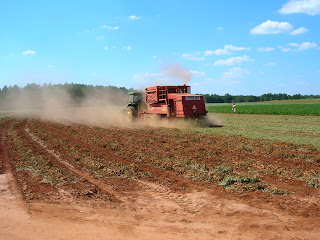Here we are in the hottest Summer on record in South Georgia. It is supposed to feel like Fall but even though this morning was a bit cooler I still don't feel it.
Peanut prediction models continue to show a yield decline. One county agent told me the dry land peanuts he has looked at have mold on the
kernels when they shell the peanuts to look at them. The hope of rain from the active hurricane season we were to have just never came. There have also been reports of
Seg. 2 peanuts which would indicate damage due to the dry weather. The ground where farmers can't irrigate is hard and we really need a rain just to get where we can dig in those fields. As if this is not bad enough the State Climatologist says the drought will likely continue in 2011.
It is heartbreaking to me to talk to farmers who I know are good farmers and are telling me they may not be able to farm next year. The concern is this may be the straw which broke the camel's back. It costs so much to make a crop on a commercial sized family farm and when you look at losses of half to three quarters of a million dollars that is hard to overcome.
I think all the talk about a surplus of peanuts has pretty much evaporated with the excessive heat and drought.
If I was a farmer with
un-contracted, irrigated peanuts I would be as patient as the banker would let me be because I truly believe the price should improve from this point forward.
Now for 2011, if cotton prices hold it is going to be hard for the industry to excite farmers about planting peanuts in lieu of cotton unless
pre-plant contracts for peanuts have a 5 for the first number and in some areas that number may even need to have a 5 or better as the second number.
I have been looking at the National Center for Peanut Competitiveness representative farms and those farms support my gut feel.
One bright spot came when a farmer told me his input costs were down from last year on a per unit basis.
Sadly, we could have used some disaster assistance for last year's wet harvest or for this year's excessive heat and drought but USDA chose to help farmer in Arkansas but little anywhere else and Congress failed dismally by not passing a disaster bill which would have helped farmers across the country. Don't fuss and ask why we should have the government bail out farmers, farm programs have stabilized food prices and just think about going to the store and finding empty shelves and prices double or triple what they are now. It is good business for everyone who likes to eat.
I am pretty well convinced many farmers have found themselves in a debt crisis but it seems Wall Street speculators are more important than the folks who feed and clothe us.










